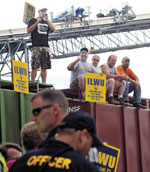
Showdown on West Coast Docks: The Battle of Longview
(November 2011).
click on photo for article
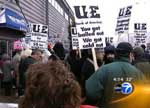
Chicago Plant Occupation Electrifies Labor
(December 2008).
click on photo for article
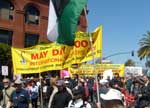
May Day Strike Against the War Shuts Down
U.S. West Coast Ports
(May 2008)
click on photo for article

December 2022
Biden,
DSA’s AOC and “Squad” Vote to Ban Rail Strike
Democratic
Party Strikebreakers
Shackle Railroad Workers
Rip Up
the Railway Labor Act with a Powerful Rail / Truck
/ Port Strike!
Break
with the Bosses’ Parties and Politicians – Build a
Workers Party!
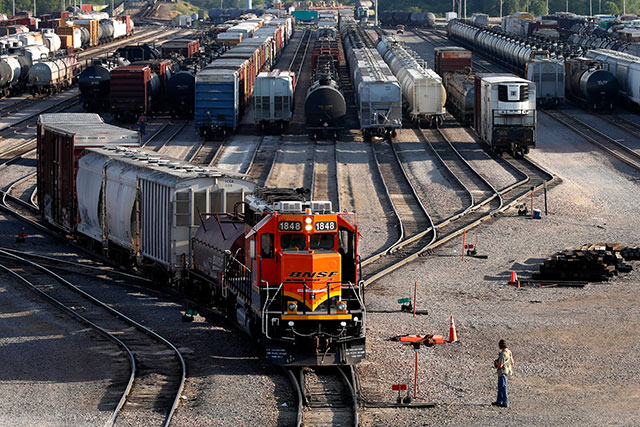
Freight train departing from switching yard in Galesburg, Illinois, June 2021. In the name of “economic stability,” Democratic president Biden and Democrat-controlled Congress imposed contract with no paid sick leave after a majority of railroad workers voted against it. Capitalist Democrats are no “friends of labor.” (Safkat Anowar / AP)
At the beginning of December, some 115,000 railroad workers were poised to walk off the job, tying up 40% of all U.S. freight, at the height of the holiday shopping season. A majority had voted against a Tentative Agreement (TA) that outrageously did not include even one paid sick day. A major labor battle was posed. Instead, Democrat Joe Biden, who proclaimed himself the “most pro-union president you’ve ever seen,” signed legislation passed by Democrats in both houses of Congress, imposing a presidentially dictated contract and banning a strike. This blatant strikebreaking sums up countless reasons why the capitalist Democratic Party is a noose around the neck of labor. This underlines why workers urgently need to break with all the bosses’ parties and build a class-struggle workers party to lead the battles of all the oppressed.
A Showdown Between Labor and Capital Posed
Unionized rail workers in the United States had been working for three years without a contract. Even before that, over the last six years, the freight rail companies slashed their workforce by nearly 45,000 workers – almost 30% of the total. There were 20,000 laid off in 2019 alone. This job-destroying operation is the product of the Precision Scheduled Railroading (PSR) system, the gospel of today’s railroad owners. Cutting down on idle time for freight cars, it has led to longer trains (often two miles long or more) with two-person crews (formerly five) working killer schedules. It also means fewer inspections, deteriorating track and more accidents affecting workers and passengers, while shippers complain of deteriorating service. Providing time-off benefits contradicts railroads’ whole business strategy. So the bosses flat-out refuse.
PSR sacrifices safety, service and railroaders’ working lives and livelihoods to maximize profits. The seven Class I railroads (BNSF, Canadian National Railway, Canadian Pacific, CSX, Kansas City Southern, Norfolk Southern and Union Pacific) are awash in money. The business news site Bloomberg (3 August 2022) reported: “Adjusted operating [profit] margins for the five largest U.S. railroads were 41% last year, compared with 29% 10 years ago and 15% less than a couple of decades ago.” Meanwhile, payouts to shareholders have skyrocketed. A New Yorker1 article reports that “Between 2011 and 2021, the big railroads spent a hundred and ninety-one billion dollars on dividends and stock buybacks, which was far more than the hundred and thirty-eight billion dollars they spent on capital investments in the industry’s infrastructure.”

From Cornelius Vanderbilt (left) and Jay Gould (center) to Warren Buffett, owner of the BNSF railroad, cutthroat robber barons all. (Photos: Wikipedia; Library of Congress; Philip Morigi)
Like the original railroad barons, Jay Gould, Cornelius Vanderbilt, Leland Stanford, et al, today’s lords of the rails are cutthroats. Warren Buffett, owner of the BNSF line, sometimes puts on populist airs, like when he said back in the 1980s, “There’s class warfare, all right, but it’s my class, the rich class, that’s making war, and we’re winning.” They still are. Increasingly, Wall Street financial operators are milking the railroads as cash cows.2 Like the deregulation of the airlines by the Democratic Carter administration, the Staggers Rail Act of 1980 (named for Democratic congressman Harley Staggers) let railroads shut down unprofitable lines and determine freight rates (previously set by the Interstate Commerce Commission). So while in 1976 there were 63 Class I railroads, now there are seven, controlling over 80% of the market.3
Railroaders were deemed “essential workers” and toiled through the COVID-19 pandemic without a break. With reduced numbers, their workload increased sharply in 2021-22 as huge backlogs developed in the just-in-time supply chain. In addition to layoffs, many rail workers resigned before retirement as their working conditions grew worse and worse. Glass Door, the job evaluation web site, rated Union Pacific and Norfolk Southern the two absolute worst U.S. companies to work for, and a third railroad (CSX) as No. 5. By this past summer the push for better contracts was building up a head of steam among rail workers. When rail unions rejected binding arbitration on June 16, a 30-day “cooling-off” period began, during which strikes are prohibited under the 1926 Railway Labor Act (RLA).
Then on July 15, President Biden appointed a Presidential Emergency Board (PEB), which began a second “cooling-off” period, this time for 60 days, under the elaborate provisions of the RLA. Ever since the Great Railroad Strike of 1877 (which sparked a general strike in St. Louis and week-long union control of East St Louis) was broken by company goon squads, state militias and U.S. troops, railroad labor has been tightly regulated by federal law. After World War I, the Railway Labor Board slashed workers wages by 12% and outlawed a 1922 rail strike. As the unions refused to deal with that Board, the RLA was passed to impose a regime of supposedly “neutral” arbitration and, ultimately, presidential control. By mid-September 2022, the rail union chiefs were plenty “cooled off” while many in the ranks were hot under the collar.
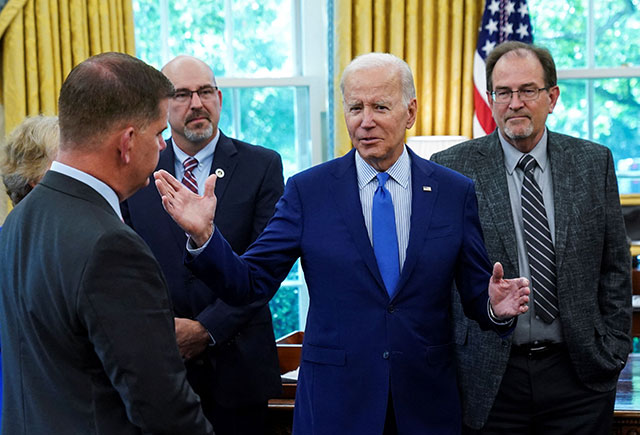
President Joe Biden with negotiators who brokered the rail labor “agreement” with no paid sick days, September 15. Rail workers voted it down, Biden and Congress imposed it. (Kevin Lamarque / Reuters)
On September 15, Biden proclaimed with much fanfare that an agreement had been reached, one day before the strike ban expired. The new “agreement” between the Association of American Railroads and leaders of the 12 rail unions was brokered Biden’s labor secretary Marty Walsh, the former mayor of Boston and one-time skilled trades construction union leader. It included a 24% wage increase over five years starting in 2020 (when the last contract expired). That averages out to 4.8% per year, while the current rate of inflation is 7.7% – so the “pay hike” amounts to a pay cut! Above all, this contract – now imposed by Biden and the Democratic-led Congress – provides for one additional paid “personal day” off and no paid sick leave. (Members of Congress have unlimited paid sick leave.)
Within days, the members of the Brotherhood of Maintenance of Way Employes (BMWED) and the Brotherhood of Railway Signalmen (BRS) voted “no,” as did the International Brotherhood of Boilermakers (IBB) in October. Although the Brotherhood of Locomotive Engineers and Trainmen (BLET, which along with the BMWED is part of the Teamsters), with 24,000 members, ratified the deal based on the “recommendations” of the PEB, the White House got really nervous when on November 21 the International Association of Sheet Metal, Air, Rail and Transportation Workers (SMART-TD), the largest rail union, representing 28,000 conductors, brakemen, yardmen and others, gave the thumbs down to Biden’s shotgun deal. If even one of the unions picketed rail yards, the other rail unions pledged to honor the pickets.
The stage was set for an epic showdown between labor and capital, between the workers and the bosses. Once again, the bosses won – thanks to the actions of the capitalist Democratic Party, which is backed by the leadership of almost all sectors of the railroad unions. As bargaining went nowhere, the railroads turned to the politicians. With the unions hamstrung by the Railway Labor Act – which since 1936, thanks to Democratic president Franklin D. Roosevelt, also includes airline workers – once the Democrat-controlled Congress acted to make a strike illegal, that was it. Game over. Or is it? That assumes everyone plays by the bosses’ rules, which means that workers are sure to lose. But it doesn’t have to be that way. As the Internationalist Group has underlined time and again, labor’s gotta play hardball to win.
Democrats, Including the DSA “Squad”: Strikebreakers and War-Makers
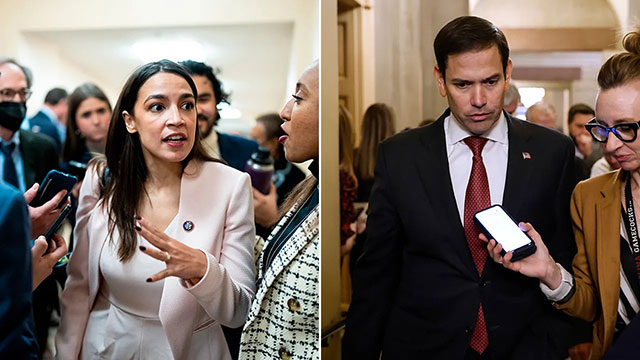
Strikebreakers: DSA Democrat Alexandria Ocasio-Cortez of “The Squad” and right-wing Republican Marco Rubio as strike ban law was railroaded through Congress. Fox Business News headlined: “AOC, Rubio Find Common Ground.” (Photos: Bill Clark / CQ-Roll Call; Anna Moneymaker/ Getty)
On Monday, November 28, Joe Biden called on Congress to act. Two days later, on November 30, after piously lamenting the rail bosses’ “obscene profits [made] on the backs of workers,” Democratic House Speaker Nancy Pelosi declared, “Let me be clear: a nationwide rail shutdown would be catastrophic.” That night, the House voted overwhelmingly to deny rail workers the right to strike, while 136 Republicans, for their own reactionary reasons, voted against bill. Among those voting for the strike-ban bill (Joint Resolution 100) imposing a rotten contract on rail workers – wielding the bosses’ anti-labor law to suppress the workers’ right to strike – were “progressive” Democratic Congress members Alexandria Ocasio-Cortez, Cori Bush and Jamaal Bowman, members of the Democratic Socialists of America (DSA).4 The DSA Democrats and their fellow members of “The Squad” are in fact capitalist politicians, and now certified strikebreakers … as well as imperialist war-makers, having voted for Biden’s $40 billion arms and economic support (and subsequent aid packages) to arm and finance Ukraine spearheading the NATO-provoked war with Russia.
In a “CYA” (cover your ass) piece of parliamentary theatrics, the “progressives” got Pelosi to go for a second bill, calling for seven days of paid sick leave, which was also approved by the House. This was a completely cynical ploy, since Pelosi, AOC and the rest – while doing the dirty work of backing Biden in fastening the RLA’s chains on the workers to “illegalize” their very right to strike – knew that this “seven-day” bill would never make it through the Senate. So on December 1, the Senate passed the strikebreaking bill and, sure enough, there were no sick days. On December 2, Biden signed it into law, a week before the strike deadline. Who says Washington can’t get anything done? Strikebreaking is bipartisan. When bottom-line class interests are at stake, the legislative and executive branches of government and the feuding capitalist parties can move with lightning speed.
The imposition by a Democratic-led Congress and a Democratic president of a strikebreaking contract which had been voted down by the unions’ membership is proof positive that the Democrats are no “friends of labor,” as they sometimes claim to be. This is already reverberating in the unions, as even the bourgeois mainstream media have noticed. The New York Times (27 December) headlined, “‘Most Pro-Union President’ Runs Into Doubts in Labor Ranks.” Some commentators noted that, “Having played the Biden card, union leaders were left with nothing” (The Intercept, 11 December). An Open Letter to President Biden and Labor Secretary Walsh by over 500 historians makes many of the same points. But instead of calling to break from the Democrats, they urged the Dems to ensure a contract with paid sick days for rail workers.
How did that work out for workers?
Many in the rail union said they were “disappointed” in Biden, having hoped he would “do the right thing” by the workers. Yet in announcing the strikebreaking law, Biden said it “was the right thing to do” to “keep the economy on a stable footing,” fight inflation, etc. The Democratic president “did the right thing” for the interests of his class – the boss class. It goes beyond Biden’s posturing and the Democrats’ grandstanding – the fact is that this capitalist party is a class enemy of workers. Moreover, the state they are an integral part of is no neutral arbiter but the armed fist of capital. This was laid out by Karl Marx and Friedrich Engels in the Communist Manifesto (1848), which stated that “The executive of the modern state is but a committee for managing the common affairs of the bourgeoisie,” that is, the capitalist ruling class.
As for the 500+ historians who called on the rulers of this state to “use the full force of their formal and informal powers” to support railroad workers, V.I. Lenin could have been speaking to them when he wrote, in The State and Revolution (1917), of “the petty-bourgeois and philistine professors and publicists” who “correct” Marx by trying “to make it appear that the state is an organ for the reconciliation of classes.” On the contrary, Lenin insisted: “According to Marx, the state is an organ of class rule, an organ for the oppression of one class by another; it is the creation of ‘order,’ which legalizes and perpetuates this oppression by moderating the conflict between classes.” Any “moderating” of the class conflict is for the purpose of “depriving the oppressed classes of definite means and methods of struggle to overthrow the oppressors.”
Union Bureaucracy: Labor Lieutenants of Capital

Union leaders Dennis Pierce of the BLET (left) and Jeremy Ferguson of SMART-TD in October video pushing the no-sick-pay contract negotiated under Biden's Presidential Emergency Board. Days after the Democrats imposed the contract, the BLET membership ousted Pierce in favor of a candidate who campaigned against it. (Photo: BLET / IBT)
This brings us to the role of the pro-capitalist union bureaucracy … and the reformist opposition. In September, the leaders of all 12 rail unions approved the government-brokered contract that the rank and file is now saddled with. When four unions and the majority of rail workers rejected the pact, it should have been the signal for immediate, although long overdue, preparation for a strike. Instead, SMART-TD president Jeremy Ferguson stated “This can all be settled through negotiations and without a strike. A settlement would be in the best interests of the workers, the railroads, shippers and the American people.”5 In other words, he was pleading with the administration to take him off the hook. In toeing the line laid down by the rail barons and banning a strike, Biden, Walsh and Congressional Democrats also gave pro-capitalist labor “leaders” like Ferguson his wish.
Even after Biden had signed the no-strike, no-sick-leave law, on December 9, when no trains should have been moving, the AFL-CIO Transportation Trades Department stated: “The fight to guarantee paid sick leave for rail workers is not over and we will not back down until we win. We are committed to aggressively pursuing further action by both parties in Congress and the President, including the strategic use of legislation and Administration action….”6 Oh, great: more hat-in-hand appeals to the bosses’ politicians who denied rail workers their most basic right – the right to withhold their labor! Instead of preparing the ranks for a fight, these misleaders of labor are still seeking to pressure the bosses’ government. This is the model of “business unionism,” in which labor leaders see their role as providing a stable and disciplined workforce for the bosses to exploit.
It is important to stress that the union bureaucracy is not just a bunch of sellouts who are pushovers for the bosses, personally corrupt – or not – but is a petty-bourgeois social layer seeking to balance between the union ranks and the bosses. It is this layer that the U.S. socialist Daniel De Leon referred to in 1900 as “capital’s labor lieutenants.” Although they sit atop the unions, which are workers organizations that they are sometimes obliged to defend (if only to protect their own privileged positions), their fundamental loyalties are to the capitalist system. So when Ronald Reagan targeted the PATCO air controllers union in the early 1980s, the rest of the labor bureaucracy stood by and in many cases even helped break their strike. Ever since, one union gain after another has been destroyed and many unions broken, with hardly any resistance from the union tops.
Moreover, this pro-capitalist labor bureaucracy was put in power by the capitalist rulers, with the Democrats in the forefront, in the “red purge” that ousted communist and socialist union leaders at the onset of the post-WWII anti-Soviet Cold War. This was part of a broader pattern. In his unfinished essay “Trade Unions in the Epoch of Imperialist Decay” (1940), Leon Trotsky, who together with Lenin led the 1917 Bolshevik Revolution in Russia, wrote that, “There is one common feature in the development, or more correctly the degeneration, of modern trade union organizations in the entire world: it is their drawing closely to and growing together with the state power.” Trotsky’s answer was not to write off the unions but to fight for a revolutionary program within them:
“The primary slogan for this struggle is: complete and unconditional independence of the trade unions in relation to the capitalist state…. The trade unions of our time can either serve as secondary instruments of imperialist capitalism for the subordination and disciplining of workers and for obstructing the revolution, or, on the contrary, the trade unions can become the instruments of the revolutionary movement of the proletariat.”
Unless oppositionists in the unions adopt a class-struggle program based on mobilizing the power of workers and the oppressed in revolutionary struggle against capitalism, they will face the prospect of ending up like the sellout leaders they are seeking to replace. The decaying capitalist system, which is systematically destroying past gains, has no room for enduring reforms and can only survive by driving down the living standards of those whose labor it exploits to generate its profits. What’s happening to railroad workers is happening to working people across the country and throughout the capitalist world. As an Internationalist Group sign at a December 8 solidarity-with-railroad-workers rally at New York City’s Grand Central Station read: “Sellout Union Tops Roll Over for Democratic Party Strikebreaking – Rail Workers Need Class-Struggle Leadership.”
Oust the Bureaucrats, Break with the Democrats, Build a Workers Party!
This is a very different perspective than that being put forward by oppositions in the railroad unions today. That many rail workers want to fight is clear. Recently, the BLET division of the Teamsters elected a new president, Eddie Hall, who campaigned against the tentative agreement agreed to by his predecessor, criticizing the fact that the union leaders didn’t strike after it was (finally) legal to do so. In the BMWED, the Rank and File United (RFU) caucus criticized the TA, but didn’t take an official position against it, while Railroad Workers United (RWU), which is active in several unions, campaigned against it. But what none of them did was to say it’s time to hit the bricks, now, rather than looking to the White House and Congress. Instead, they sought to maneuver with the “progressive” Democrats in Congress and their seven-days-sick-pay ploy.
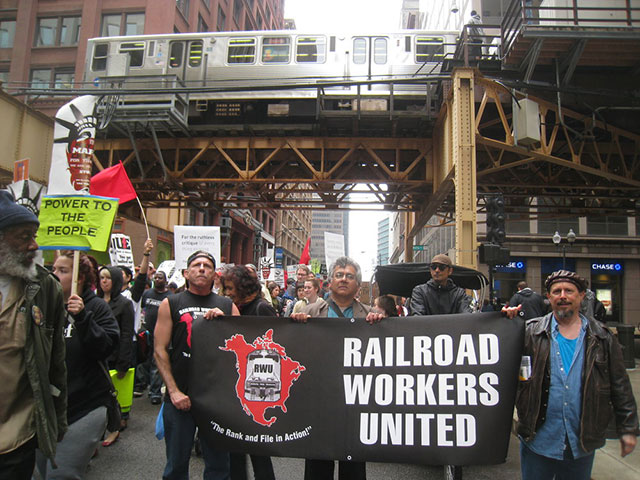
Railroad Workers United demonstrate in Chicago. (Photo: RWU)
The Intercept quotes Ross Grooters of the RWU saying that rail workers weren’t “concerned about the Squad” and its vote to impose the contract. He went on: “Is it strike-breaking on the one hand? Yes. But it’s a distraction from the work that needs to happen,” calling criticisms of Bowman and other DSAers “misplaced.” (Grooters is a DSA city council member in Pleasant Hill, Iowa.) The RWU, RFU and other rail union oppositionists were at the Labor Notes conference in Chicago in June, where they met others in this milieu working in league with, if not directly in, the Democratic Party.7 In a Labor Notes (2 December) article titled “What Would It Take for Rail Workers to Win?” Grooters refers to Sarah Nelson of the flight attendants union having “found ways to work within the RLA,” with rolling strikes and the like.
But to win, rail workers and all workers will have to go up against the government, prepared to defy back-to-work injunctions, strike bans and the whole arsenal of anti-labor laws meant to hogtie the unions (Taft-Hartley bans on “secondary strikes,” Supreme Court prohibition of sit-down strikes, state legislation like New York’s Taylor Law outlawing strikes by public workers, etc.). In the past, some hard-knuckle union leaders have stared down judges and presidents, like United Mineworkers leader John L. Lewis, who called coal miners out on strike – three times – in 1943 in the middle of the imperialist World War II. “You can’t mine coal with bayonets,” Lewis defiantly declared. But Lewis was no class-struggle militant and ended up supporting the Republicans in the 1944 elections, eventually knuckling under to the state.
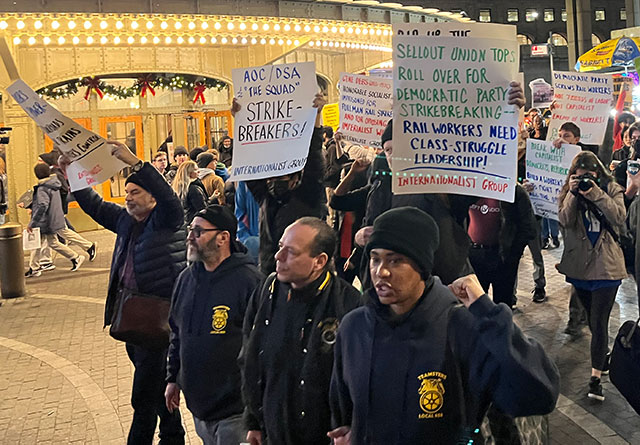
Internationalists in December 8 solidarity with railroad workers march in New York City's Grand Central Station. (Internationalist photo)
A fighting union leadership must be built on a program of militant class struggle down the line. While reformists talk of “public ownership” of the rail lines – like Amtrak! – a class-struggle opposition would call for expropriating the robber barons who own the railroads, and would enforce workers control, beginning with union safety committees empowered to shut down unsafe working conditions. The rail bosses are once again on a tear trying to impose one-worker crews – on giant trains, often with more than 200 freight cars – ultimately aiming for driver-less trains. The RWU has a perceptive article8 detailing how reducing crews to a single person is a huge safety danger. But what may soon be posed is the need for an all-out rail strike to stop one-person crews, defying everything the capitalist state can throw at strikers.
That underlines the fact that it will take a revolutionary leadership to win! Railroad workers cannot defeat the bosses and their government working “within the RLA.” As an Internationalist Group speaker at the New York December 8 solidarity rally noted: “We need to bust that union-busting law, by shutting it down, with the power of the rail workers, the MTA [transit] workers and the Teamsters, who also have a contract coming up soon.” To break the chains of the infamous Railway Labor Act, class-conscious workers should fight for an all-out national transportation strike, including railroad workers, airline workers, dock workers (the West Coast ILWU is working without a contract), the port truckers and the Teamster truckers. This is also the kind of militant mobilization of workers power that could unionize Amazon, as well as Walmart and other virulently anti-union chains. Then, in the words of IWW (Industrial Workers of the World) agitator Joe Hill, quoted by the IG speaker:
“If the workers take a notion they can stop all speeding trains; Every ship upon the ocean, they can tie with mighty chains. Every wheel in the creation, every mine and every mill; Fleets and armies of the nation, will at their command stand still.”
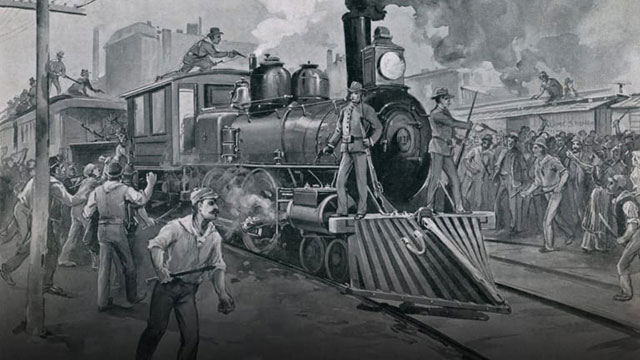
American Railroad Union president Eugene V. Debs (below, right) led the 1894 Pullman railroad strike defying injunctions and violent strikebreaking. (Photos: public domain; Harper's Weekly)
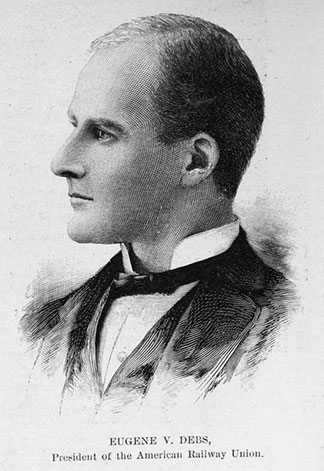
To wage and win such a battle, it is necessary to overcome craft divisions and form one big fighting railroad union united in struggle with other transportation workers. A genuine class-struggle union would necessarily take action to make solidarity a reality, embracing the slogan of the IWW (and the ILWU): “An injury to one is an injury to all.” The ILWU gave expression to this mighty call by shutting down every port on the U.S. (and Canadian!) West Coast on Juneteenth (June 19) in 2020 denouncing police brutality and systemic racism. Among railroad workers, the fight against racial oppression and for full equality is crucial today as it was in 1894, when the strike of the Pullman rail car workers was undercut by the refusal of the American Railway Union (ARU) to accept black sleeping car porters as members.
ARU president and future socialist leader Eugene Debs was jailed for leading that strike. We Trotskyists have taken Debs to task for his statement that socialists “have nothing special to offer the Negro” – the quintessential expression of a “color-blind” outlook of the left wing of labor, as against the racist, exclusionary right wing. Yet Debs strongly opposed racial discrimination and fought at the 1894 ARU convention against the exclusion of black workers.9 He was jailed again – under the Espionage Act! – for his courageous opposition to the imperialist World War I. Eugene V. Debs was an honorable socialist, the polar opposite of the DSA today, which is an organization of strikebreakers and war-makers. Running for president from his jail cell, Debs declared in 1919: “From the crown of my head to the soles of my feet I am Bolshevik, and proud of it.”
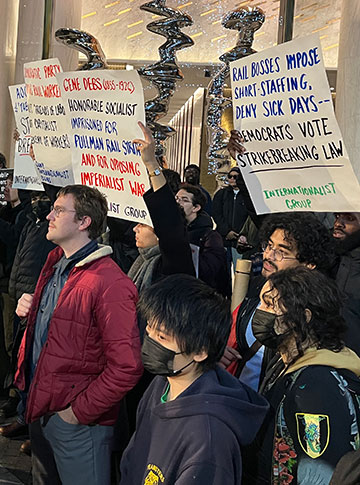
Unlike today's DSA Democrats, who are strikebreakers and war-makers, Debs was an honorable socialist who was imprisoned for leading the 1894 Pullman strike and again in 1918 for opposing imperialist World War I. (Internationalist photo)
Joe Biden’s use of the Railway Labor Act to block a strike by railroad workers was hardly the first time that Democrats have used the power of the capitalist state against the workers. In the coal strike of 1978,10 Democratic president Jimmy Carter used the Taft-Hartley Act to repeatedly issue injunctions trying to block a mine strike and force miners to accept a sellout contract, which they repeatedly tore up and burned. The miners finally gave in for lack of a class-struggle leadership to oust the UMWA’s “reform” president Arnold Miller, who came to office in a Labor Department supervised election of the sort pushed by Labor Notes and Teamsters for a Democratic Union. Once in office thanks to the feds, the government owned him – as they did with TDU-backed Ron Carey, until jailing him for funneling dollars to Democrats.
Concluding his remarks at the December 8 rally, the Internationalist speaker asked the crowd, “Is Joe Biden a strikebreaker?” The crowd yelled the answer, “Yes!” He continued: “Is the Democratic Party strikebreakers?” Again, the answer was “Yes!” Well, then, he went on, “Are we going to remain silent about the DSA ‘Squad’ who voted for this?” The crowd responded, “No!” The IG speaker concluded: “Hell no!. We need to break with the Democrats and Republicans and build a fight workers party!” That struggle for a workers party and a workers government is the program that is needed for railroad workers, and all working, poor and oppressed people, to win. ■
- 1. “The Averted National Rail Strike Is a Parable of Contemporary American Capitalism,” New Yorker, 6 December.
- 2. “BNSF, for example, is 46 percent owned by Wall Street investment funds. At CSX, the figure is 35 percent; at Union Pacific, 34 percent; at Kansas City Southern, 33 percent; and at Norfolk Southern, 32 percent, according to Bloomberg News,” from “Who owns the railroads,” SMART, 21 June 2009.
- 3. That will be reduced to six if the proposed merger of Canadian Pacific and Kansas City Southern goes through.
- 4. Rashida Tlaib was the only one of this crew who voted against H.J.R. 100.
- 5.“Split decision: Unions for engineers and conductors take different routes in freight rail contract ratification vote,” SMART, 21 November.
- 6. “AFL-CIO TTD: Rail labor will not rest until freight rail industry is fixed and rail workers are treated fairly,” SMART, 9 December.
- 7. See “Labor Notes Conference 2022: ‘Solidarity’ with the Democrats,” in The Internationalist Nos. 67-68, May-October 2022.
- 8. “What’s Wrong with Single Employee Train Operations?” at www.railroadworkersunited.org.
- 9. Eugene V. Debs, “The Color Line and the American Railway Union: Comments at the Convention” (18 June 1894). On the merits and limitations of Debs, and related topics, see, by James P. Cannon (founder of American Trotskyism): “E.V. Debs” (1956) and “The Russian Revolution and the American Negro Movement” (1959).
- 10. See the pamphlet The Great Coal Strike of 1978 on the Internationalist web site (www.internationalist.org).